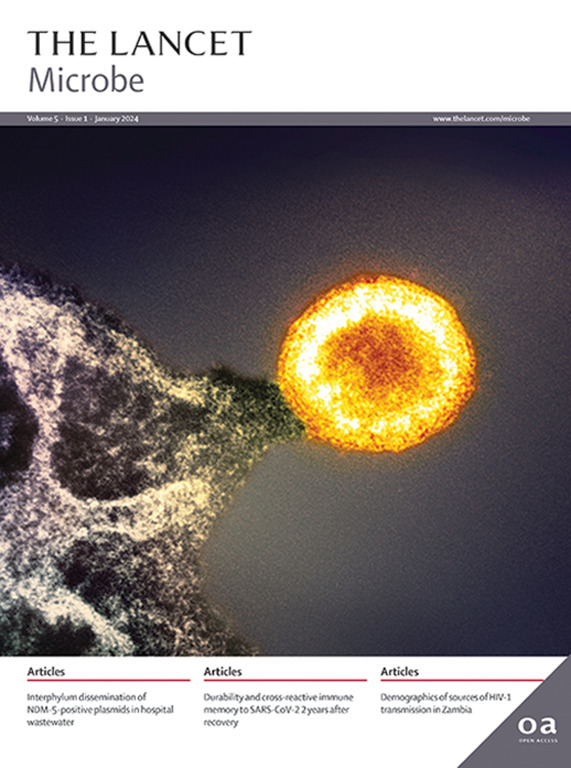The spread of molecular markers of artemisinin partial resistance and diagnostic evasion in Eritrea: a retrospective molecular epidemiology study
IF 20.9
1区 生物学
Q1 INFECTIOUS DISEASES
引用次数: 0
Abstract
Background
Eritrea was the first African country to discontinue the use of histidine rich protein 2 (HRP2)-detecting rapid diagnostic tests (RDTs) for malaria diagnosis following reports of a high prevalence of pfhrp2/3-deleted Plasmodium falciparum parasites causing false-negative results in the country. Eritrea was also the first African country to report partial artemisinin resistance due to the P falciparum kelch13 (pfk13) Arg622Ile mutation. We aimed to characterise the spatial distribution of pfk13 mutants and their interactions with pfhrp2/3 deletions in Eritrea and to assess the role of the use of HRP2-detecting RDTs and antimalarial (artesunate–amodiaquine) therapy in the spread of the two variants.
Methods
We conducted a retrospective molecular epidemiological analysis of pfk13 mutations and pfhrp2/3 deletions in existing P falciparum-infected blood samples collected as part of previous pfhrp2/3 deletion and severe malaria studies. Samples were collected in March, 2016 and between September, 2018, and January, 2020, from symptomatic patients seeking care at 15 health centres in four administration zones (Semenawi Keyih Bahri, Gash Barka, Anseba, and Debub) in Eritrea. A fragment spanning the propeller region of pfk13 was amplified from samples and sequenced using Sanger sequencing or targeted amplicon sequencing to identify genetic mutations. Deletions of pfhrp2/3 genes in samples were determined using multiplex quantitative PCR. Parasite haplotypes and genetic relatedness of parasite haplotypes were determined previously using microsatellite marker typing. The primary objective was to determine the prevalence of pfk13 mutations at health centres and administrative zones. The secondary objective was to investigate whether pfk13 mutants and pfhrp2/3 deleted parasites converge.
Findings
We sequenced 50 samples collected in March, 2016 from the Semenawi Keyih Bahri zone and identified no pfk13 mutations. By contrast, in 587 samples included in this study that were collected from health centres in Gash Barka, Anseba, and Debub in 2018–20, we detected five different single non-synonymous mutations: Glu605Lys, Arg622Ile, Asn657Lys, Lys658Glu, and Ser679Leu. The most prevalent mutation was pfk13 Arg622Ile, which was detected in samples collected from all nine health centres where more than five samples were available across all three administration zones, with an overall prevalence of 11·9% (70 of 587 samples; range 5·9–28·0%). We identified 22 unique pfk13 Arg622Ile mutant haplotypes among 26 samples tested, of which 13 (59·1%) were genetically related, whereas the remaining nine (40·9%) were not. The prevalence of pfk13 Arg622Ile was significantly higher in parasites with a single pfhrp3 deletion (46 [18·0%] of 255 samples) than in parasites without pfhrp2/3 deletions (ten [6·2%] of 161 samples; odds ratio 3·89 [95% CI 1·59–7·61]; p=0·0006) and with dual pfhrp2/3-deleted parasites (13 [9·0%] of 145; 2·23 [1·13–4·68]; p=0·018).
Interpretation
The geographical spread of the pfk13 Arg622Ile mutation might have initially resulted from the clonal expansion and spread of pfhrp2/3 deletions under the test-and-treat policy using HRP2-detecting RDTs. Subsequently, selective pressure from artemisinin combination therapy could have further facilitated the spread of both pfk13 Arg622Ile and pfhrp2/3 deletions. Continuous monitoring of trends in pfk13 and pfhrp2/3 variants is needed to inform effective malaria control and elimination strategies in Eritrea and other African countries.
Funding
US Department of Defense Armed Forces Health Surveillance Division, Global Emerging Infections Surveillance Branch (AFHSD/GEIS), and Wellcome Trust.
青蒿素部分耐药和漏诊分子标记在厄立特里亚的传播:回顾性分子流行病学研究
背景:厄立特里亚是第一个停止使用富组氨酸蛋白2 (HRP2)检测快速诊断试验(RDTs)进行疟疾诊断的非洲国家,此前有报告称,该国高流行的富组氨酸蛋白2/3缺失的恶性疟原虫导致假阴性结果。厄立特里亚也是第一个报告因恶性疟原虫kelch13 (pfk13) Arg622Ile突变而产生部分青蒿素耐药性的非洲国家。我们的目的是表征厄立特里亚pfk13突变体的空间分布及其与pfhrp2/3缺失的相互作用,并评估使用hrp2检测rdt和抗疟疾(青蒿琥酯-阿莫地喹)治疗在两种变体传播中的作用。方法:我们对pfk13突变和pfhrp2/3缺失的现有恶性疟原虫感染血液样本进行了回顾性分子流行病学分析,这些样本是之前pfhrp2/3缺失和严重疟疾研究的一部分。2016年3月和2018年9月至2020年1月期间,从厄立特里亚四个行政区(Semenawi Keyih Bahri、Gash Barka、Anseba和Debub)的15个卫生中心就诊的有症状患者中采集了样本。从样本中扩增出跨越pfk13螺旋桨区域的片段,并使用Sanger测序或靶向扩增子测序进行测序,以确定基因突变。采用多重定量PCR检测样品中pfhrp2/3基因的缺失。寄生虫的单倍型和遗传亲缘关系以前是用微卫星标记分型确定的。主要目标是确定pfk13突变在保健中心和行政区域的流行情况。次要目的是研究pfk13突变体和pfhrp2/3缺失寄生虫是否会聚。研究结果:我们对2016年3月从Semenawi Keyih Bahri区收集的50份样本进行了测序,未发现pfk13突变。相比之下,在2018- 2020年从Gash Barka、Anseba和Debub的卫生中心收集的587份样本中,我们检测到5种不同的单一非同义突变:Glu605Lys、Arg622Ile、Asn657Lys、Lys658Glu和Ser679Leu。最普遍的突变是pfk13 Arg622Ile,在所有9个卫生中心收集的样本中检测到,所有3个行政区都有5个以上的样本,总体患病率为11.9%(587个样本中有70个;范围5·9-28·0%)。我们在26个样本中鉴定出22个独特的pfk13 Arg622Ile突变单倍型,其中13个(59.1%)与遗传相关,其余9个(40.9%)与遗传无关。单个pfhrp3缺失的疟原虫(255份样本中46份[18.0%])中pfk13 Arg622Ile的流行率显著高于非pfhrp3 /3缺失的疟原虫(161份样本中10份[6.2%]);优势比3.89 [95% CI 1.59 ~ 7.61];P = 0.0006)和双pfhrp2/3缺失疟原虫(145例中13例[9.0%];2·23(常规··68);p = 0·018)。解释:pfk13 Arg622Ile突变的地理传播最初可能是由于使用hrp2检测rdt的检测和治疗策略下pfhrp2/3缺失的克隆扩增和传播。随后,青蒿素联合治疗的选择性压力可能进一步促进了pfk13 Arg622Ile和pfhrp2/3缺失的传播。需要持续监测pfk13和pfhrp2/3变异的趋势,以便为厄立特里亚和其他非洲国家的有效疟疾控制和消除战略提供信息。资助:美国国防部武装部队健康监测处、全球新发感染监测处(AFHSD/GEIS)和威康信托基金。
本文章由计算机程序翻译,如有差异,请以英文原文为准。
求助全文
约1分钟内获得全文
求助全文
来源期刊

Lancet Microbe
Multiple-
CiteScore
27.20
自引率
0.80%
发文量
278
审稿时长
6 weeks
期刊介绍:
The Lancet Microbe is a gold open access journal committed to publishing content relevant to clinical microbiologists worldwide, with a focus on studies that advance clinical understanding, challenge the status quo, and advocate change in health policy.
 求助内容:
求助内容: 应助结果提醒方式:
应助结果提醒方式:


